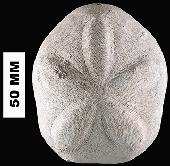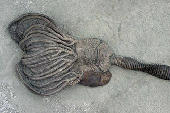|
 See More Images See More Images
(72 total)

Clypeaster rosaceus
© 2003 Roger Portell, Florida Museum of Natural History

Arthroacantha carpenteri
© 1998 Dr. Richard Paselk, Humboldt State University Natural History Museum

Platycrinites saffordi
© 2006 joe Koniecki
|
What are Echinoderms? Echinoderms, meaning “spiny-skinned,” include sand dollars, sea urchins, and sea stars, as well as less familiar creatures, such as sea cucumbers, crinoids, blastoids, and cystoids. This diverse group is entirely marine and is characterized by the presence of five-fold symmetry. Echinoderms have a specialized system of internal canals that circulates water through the body and services numerous, tiny appendages, called tube feet. They use their tube feet to move around or to capture food. First known fossil occurrence: Cambrian. Last known fossil occurrence: Quaternary. This group has living relatives. Cool Echinoderms links: Search for images of Echinoderms on Google |
See Echinoderms from the:
|
|





